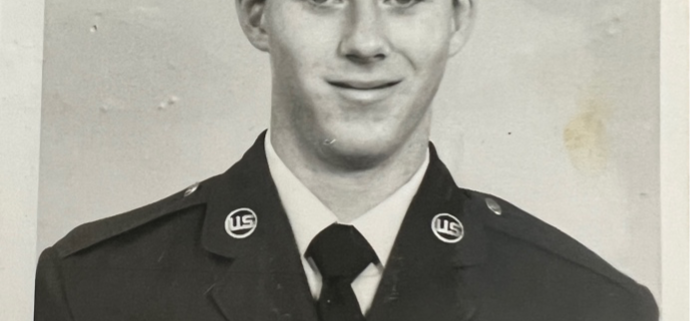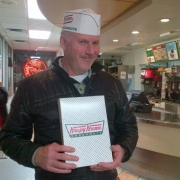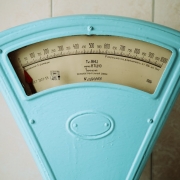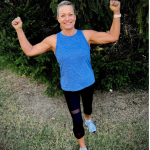How a Stoplight Can Help You Break Up with Food | Healthy Aging Series: S9 E13
I remember my first week of basic training in the United States Air Force. There’s a lot to learn. Really, it’s indoctrination. Military bearing. You’re learning to stop being a civilian and act like an Airman, a Marine, a Soldier, or a Sailor. They teach you how to salute. They show you, then have you salute, then correct you.
I remember our Sergeant teaching us how to put our laundry mark on all our clothing. They were nice enough to make us rubberstamps with the first initial of our last name, and the last four of our Social Security Number. It was like N1234.
The Sergeant gathered us around him and took an Airman’s trousers and said, “Put your stamp here,” pointing to the inside area of the zipper section. “Questions? Then go put your mark on your trousers.“ And you guessed it, someone had put his mark on the wrong spot. “Come here,” the TI said gesturing to the Airman to come close. “Give me your stamp.“ And then our Sergeant stamped the Airman’s forehead with his laundry mark. When that training session was over, and everyone had finished marking their uniforms, I noticed that two or three Airmen had two or three laundry marks on their foreheads.
I feel like one of these Airmen at times, and no, I wasn’t one of them. I need someone to teach me, show me, train me on how to do something successfully. That’s what I found in Allen Zadoff’s book, “Hungry: Lessons Learned on the Journey from Fat to Thin.” I’ve shared Zadoff’s book in part three of strategies for breaking up with food. In the first part, I looked at compulsive overeating as a disease and changing the way you look at food and yourself. Zadoff offers a visual approach to categorizing food.
A Stoplight.
Red light foods:
These are foods that you cannot stop eating once you start. Make a list of those foods for you. Is it sugar? Ice cream or bread? Pastries? Candy? Chocolate? Popcorn with lots of butter? Potato chips? Alcohol? Actually, this is my list. And then he talks about Red Food Behaviors. This is good. “What are behaviors around the Red Light Foods” As a Behavior Analyst, I might ask where are you likely to eat these foods? Maybe it’s while you’re driving. Where do you buy these foods? When are you more likely to eat these foods and less likely to eat these foods? What are you doing when you’re not eating these foods? Are you in a gym or walking in the park? Who are you with when you eat or drink your Red Light Foods? And, when you don’t eat or drink these foods, who are you with. This is just a start. You need to do a thorough assessment of Red Food Behaviors. We’ll come back to what you’re going to do with this list in a bit.
Yellow light foods:
These are foods that you have a problem with sometimes. Yeah, bread is one of those foods for me. I love biscuits. But I have some control over Yellow Foods. Your Yellow foods could include soft drinks, pasta, processed food, fried chicken, or any kind of fast food. Make a list of your yellow foods.
And lastly, Green Light Foods:
These are foods that you have no problem stopping when you start eating them. We’re talking about things like vegetables and fruits, grilled chicken, fish, and really what we’re talking about is mostly real food.
Next, Zadoff refers to Red Foods as Trigger Foods, because once started, they trigger a powerful response in our bodies. They activate your pleasure pathway which releases dopamine. And after many, many episodes of this dopamine release, we develop dopamine resistance, and need more and more to get the pleasure response and then you guessed it. You’ve developed an addictive response to Trigger Foods. Zadoff then directs us to abstain from Trigger Foods. I know there are a lot of other ways of working with Trigger Foods besides complete abstinence, but this is the approach he took and it worked for him.
He spends time throughout his book discussing the addiction and recovery process and compares food addiction, which he calls compulsive overeating with alcoholism. And although he rarely if ever mentions Overeaters Anonymous, there is no doubt he is heavily influenced by it. I am not a compulsive overeater. I would probably fit, at times, into the Problem Eater Category that I mentioned in Episode 12 of this blog. I struggle to manage my weight. I don’t abstain from anything and probably won’t. The key food management word for me is moderation. But I am at a healthy weight. I do have Gout, which is caused from foods high in purines, so I limit those foods. Otherwise, I have no food restrictions. I mostly abstain from sugar, but I occasionally eat bread, which is almost like sugar. I have attempted to abstain from alcohol, mostly for health reasons and sleep hygiene, but have decided that moderation is a key there as well. There is no credible science that supports total abstinence from alcohol.
Zadoff suggests a support group. I would too if you’re a compulsive overeater. Overeaters Anonymous involves developing a food plan, having a sponsor, working on the 12 steps of OA. These involve the work on your emotional and spiritual issues in your life. In other words, an inside job.
I would recommend Overeaters Anonymous as one option.
So, you have Red Light Foods that are typically creating a weight management problem for you, and then there are Yellow and Green Light Foods which are typically good that you do have control over. Zadoff recommends abstaining from Red Light Food, finding a support group, and building within that support group some accountability.
And that is Overeaters Anonymous. I want to share in the next part what you can expect if you decide to join Overeaters Anonymous. There are lots of other options for weight loss and breaking up with food.
Many of the obesity memoirs I have shared use a very simple approach; eat less and move more.
I want to give you some options because breaking up is hard to do and you need as many options as you can find.
In Episode 15, I’ll share in more detail OA!
To read more entries in the Healthy Aging series, click here.













